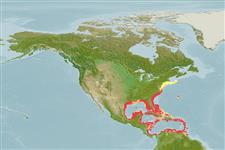Classification / Names
Common names from other countries
Main reference
Size / Weight / Age
Max length : 89.0 cm TL male/unsexed; (Ref. 55); common length : 40.0 cm TL male/unsexed; (Ref. 55); max. published weight: 20.0 kg (Ref. 4883); max. reported age: 21 years (Ref. 55)
Length at first maturity
Lm 32.0, range 21 - ? cm
Environment
Marine; freshwater; brackish; reef-associated; amphidromous (Ref. 55); depth range 5 - 180 m (Ref. 55), usually ? - 50 m (Ref. 9626)
Climate / Range
Subtropical, preferred ?; 42°N - 9°N, 98°W - 59°W (Ref. 55231)
Distribution
Western Atlantic: Massachusetts south along U.S. coast, Bermuda, the Bahamas, and throughout the Gulf of Mexico and Caribbean Sea. Records from Brazil are based on misidentifications (Ref. 113893). Records from the eastern Atlantic are vagrants (Ref. 10795).
Countries | FAO areas | Ecosystems | Occurrences | Introductions
Short description
Dorsal
spines
(total): 10;
Dorsal
soft rays
(total): 13-14;
Anal
spines: 3;
Anal
soft rays: 7 - 8. Dorsal profile of head slightly concave, snout long and pointed. Preopercular notch and knob weak. Scale rows on back parallel to lateral line anteriorly, but rising obliquely posteriorly, below soft part of dorsal fin. Young specimens with a dark stripe from snout through the eye to upper opercle and a blue stripe on cheek below eye.
IUCN Red List Status (Ref. 115185)
Threat to humans
Reports of ciguatera poisoning (Ref. 31172)
Human uses
Fisheries: commercial; gamefish: yes; aquarium: commercial
Tools
Special reports
Download XML
Internet sources
Estimates of some properties based on models
Phylogenetic diversity index
PD50 = 0.5000 many relatives (e.g. carps) 0.5 - 2.0 few relatives (e.g. lungfishes)
Trophic Level
4.2 ±0.3 se; Based on diet studies.
Resilience
Medium, minimum population doubling time 1.4 - 4.4 years (K=0.10; tm=2-3; tmax=21)
Vulnerability
Moderate vulnerability (40 of 100)
Price category
